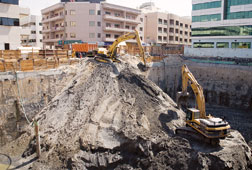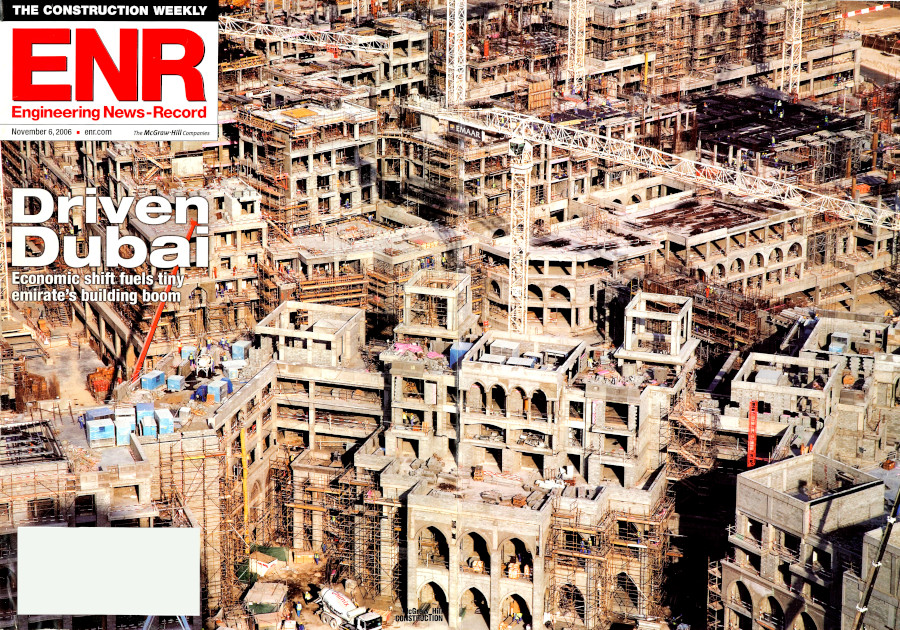Dubai Takes First Steps in Building Region's First Metro
Piling rigs around Dubai mark the start of construction of the Middle East’s first metro, intended to abate growing traffic congestion in the hyperactive emirate. Tunneling is due to begin in January on the project, expected to employ up to 9,000 workers through the middle of 2010. In a hurry as ever, the municipality gave a Japanese-led construction joint venture 49 months, until September 2009, to complete the first 52-kilometer Red Line.
In August, the government authorized Dubai municipality’s Roads and Transport Authority to exercise an option to include the 17.6-km Green Line in the contract. Green Line construction will follow the Red by six months, says Bassam Mansour, RTA’s director of engineering for railways. “Given the challenges we have had in terms of site investigations, traffic and utility diversions, it’s going O.K....We have finished the first TBM shaft,” he says.
The Red Line runs from Rashidiya, east of the airport, serving its terminals on the way to Dubai Creek. On either side of the creek, it intersects the Green Line before heading along the coast to Jebel Ali. From near the airport, the Green Line runs parallel with the Red, crosses the creek and follows it to Health Care City.
RTA set a tight six-month schedule in 2004 to bid the turnkey contract, including rolling stock. Dubai Rapid Link won with a $3.4-billion offer that was $1.6 billion less than the nearest rival bid. “It was cut-throat competition,” says Mansour.
Dubai Rapid Link is led by Mitsubishi Heavy Industries, with Obayashi Gumi Corp., Kajima Corp. and Turkey’s Yapi Merkezi Construction. For engineering design, the contractor hired U.K.’s Capita Symonds. With such a huge amount of work, the firm subcontracted packages.
Four underground stations, tunnel ventilation and utilities, for example, went to Hyder Middle East. Benaim (U.K.) Ltd. took on viaduct design and Aedas handled architecture. Austria’s Geoconsult GmbH is tunnel engineer.
 Michael Goodman/ENR
Burjuman traffic circle will become of Dubai metro’s new hubs, moving passengers along two lines that connect the existing city to new developments and the airport.
|
The design team changed this spring, when Capita Symonds withdrew, after RTA expressed concerns about the pace of work. A review was done by locally based Atkins Middle East. Atkins has become the contractor’s lead designer.
On the ground, the most visible sign of work is at the huge Burjuman traffic intersection. Across the creek, the next station, Union, is being prepared for tunneling.
Three, 9.5-m-dia earth pressure balance machines from Japan will bore the 4.7 km of twin track tunnels of the Red Line and 7.6 km of the Green, starting this January. Ground conditions are of sand, hardening with depth, and calcareous limestone. “It’s pretty much the best of both worlds, competent enough but not too soft,” says an engineer.
 Michael Goodman/ENR
|
RTA has extended the role of France’s Systra Group to supervise progress, in joint venture with Parsons, Pasadena, Calif. Another Systra-led team earlier planned the metro and drew up bidding documents. RTA’s management team is being reinforced by U.K.-based Bovis Lend Lease. The authority aims not only to build this project but establish a railroad organization, says Mansour.

 Full Dubai Coverage
Full Dubai Coverage 
